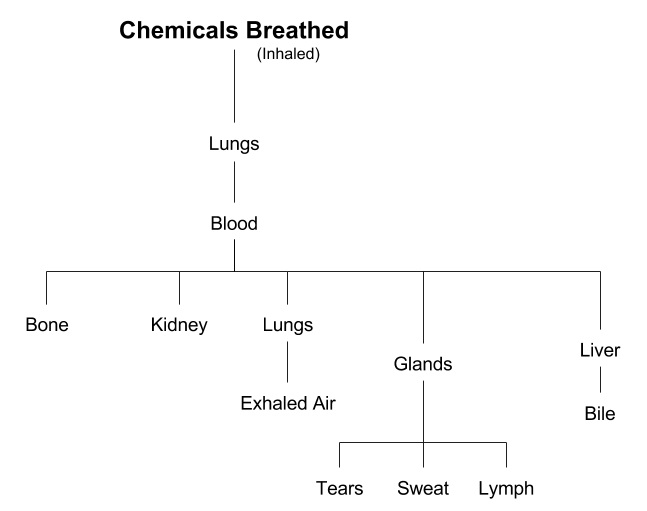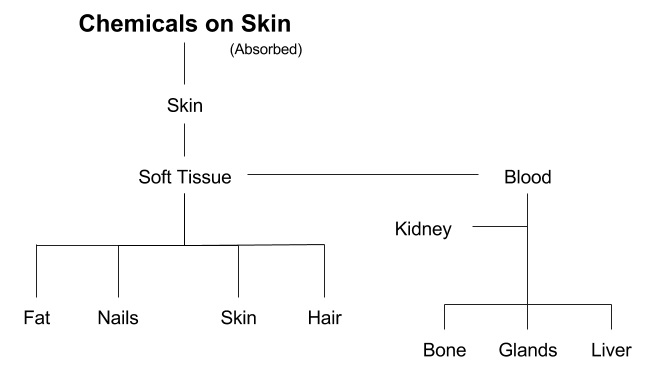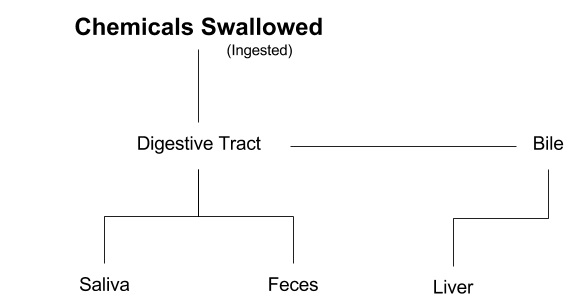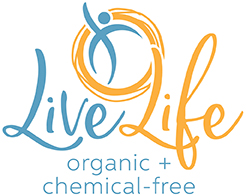I know it’s a struggle to take the time to understand what it means to live organic and chemical-free while balancing regular life stuff, family happenings, and/or work life – especially when you’re just starting to understand the ball of wax that is “chemical-free” and chemical sensitivities.
One of the top 5 things to understand is how these chemicals in our everyday products are entering our bodies in the first place.
You might be sighing and thinking, “crap, more studies and medical info to read and sort through?”
I don’t want to do that to you. Instead, I want to give you the best information and info sources that I found over the years.
Hundreds of hours of reading and researching summarized into a short few points, just for you.
Here ya go!
3 Ways Chemicals Get Into Our Bodies
Chemicals get into our bodies one of three ways, my friend: breathing, absorbing, and/or swallowing.
We created each of these graphics and related info based on the Vital Signs curriculum developed by Professor Tang G. Lee at the University of Calgery.[1] He knocked it out of the park, and his information echos that of other experts.
1. Breathing
Graphic 1: Chemicals Breathed – Travel Path

Most of the contaminants enter our bodies through our breathing.
Errr, well, we’ll have to keep breathing in order to survive, of course. While we can’t change how much we breathe (although breathing patterns do indeed change when our bodies are in “protective mode”), we CAN change what we’re breathing in.
Chemicals found in our everyday products off-gas, or release, chemicals into the air. They do this a normal temperature, and even more so in high heat and humidity.
These gasses (that are off-gassed into the air) are breathed in through our nose and mouth, aka the respiratory system, are transferred into our blood stream, and circulated through our bodies.
Well, shit! That’s not good.
Dust and mists also get into our bodies this way. So, dusts, mists, fumes, vapors, and gas all enter our bodies through breathing.[2] This not only causes respiratory problems but also neurological[3], physical[4] , and behavior disorders[5].
Dust and other particles that are larger in size enter our nose and mouths as well, but are typically caught by nose hairs and throat hairs.
It almost makes you want to shut off all openings, doesn’t it?
This gives a new meaning to the phrase “shut your hole.” :/
2. Absorbing through the skin
Graphic 2: Chemicals Absorbed by Skin – Travel Path

Skin, our largest organ, absorbs chemicals through our three layers of skin, and enters the blood stream. That blood is distributed to several organs in the body.
3. Swallowing or eating
Graphic 3: Chemicals Swallowed – Travel Path

When we eat foods and beverages made of, or exposed to chemicals, they (food, beverage, and chemicals together) travel through the digestive tract. Along the way our bodies break down and absorb the foods, drink and chemicals and then circulate the throughout the body (via the blood stream).[6]
Chemicals get into food by chemical dusts, particles, and mists either that are swallowed, or by hands, food, and cigarettes that have been contaminated and then come in contact with the mouth.[7]
What To Do About It
There it is – chemicals enter our bodies in one of three ways: breathing (inhaling), absorbing, or ingesting (eating or swallowing) them. Once these chemicals enter our bodies they are circulated throughout, and have been found to damage cells and cause long- and short-term medical conditions.
If you’re feeling overwhelmed, you’re not alone. I was overwhelmed too.
The good news is that there are simple ways we can greatly reduce the number of chemicals we’re exposed to by being aware of the things we put into the air, apply to our skin and scalp or wear, and that we eat, drink or swallow. We can choose different products, environments, ways of doing things.
It will take some time to make these changes so that they are sustainable – it’s a lifestyle change.
But I want you to know that you’re never alone in this change. Our community of fellow chemical-free and chemically sensitive people is made up of innovative problem solvers that slay the dragon every single day.
Join our growing community, Chemical-Free Problem Solvers, on Facebook right now! It’s all open-arms on our end. We’d love to have you!
References
[1] Professor Tang G. Lee. “Vital Signs, Health and the Built Environment: Indoor Air Quality.” The University of Calgary. Accessed October 24, 2016 and January 19, 2018.
[2] “How Chemicals Enter the Body,” University at Buffalo, The State University of New York, Accessed March 23, 2017.
[3] “Neurological Diseases and Disorders,” National Institute of Environmental Health Sciences, Climate and Human Health, Last Reviewed July 20, 2017.
[4] “Chemicals and You,” Environmental Health Center – Dallas, Accessed January 19, 2018.
[5] “Deeper Understanding of Link between Chemical Pollutants and Autism,” Autism Speaks, Accessed January 19, 2018.
[6] Agency for Toxic Substance and Disease Registry (ATSDR), “Module Two, Routes of Exposure,” Training Manual. Accessed January 19, 2018.
[7] “How Chemicals Enter the Body,” University at Buffalo, The State University of New York, Accessed March 23, 2017.
